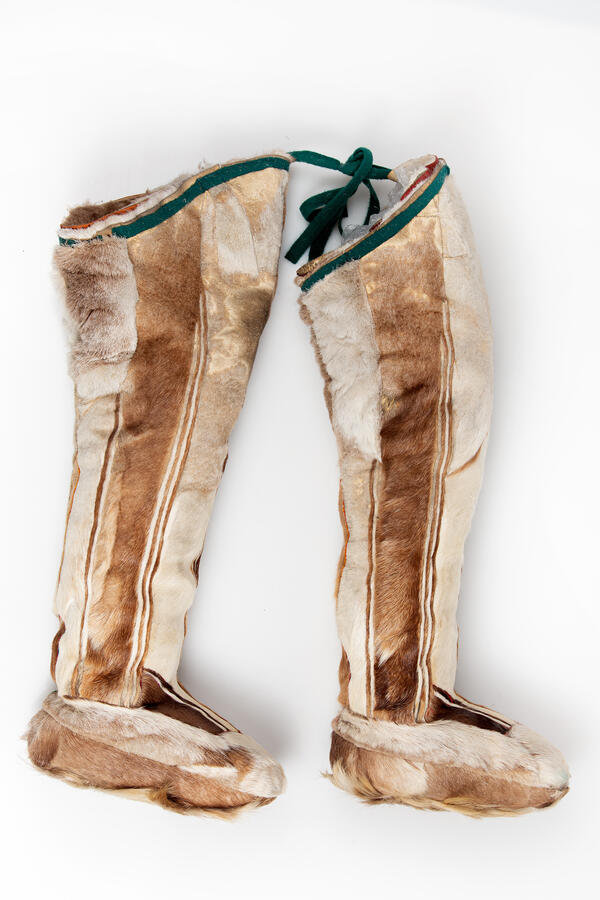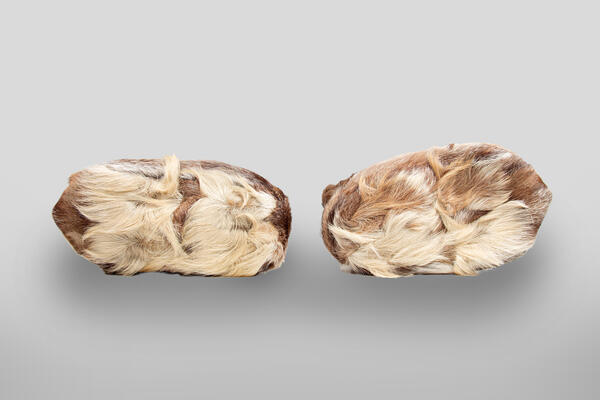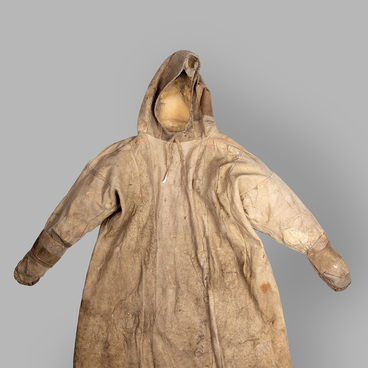Fur clothing and shoes are a prerequisite for survival in the Arctic climate for the northern peoples. All the details of the Nenets national costume are carefully thought out: it protects from frost, blizzard and strong wind, it is convenient to work in it and it has a sacred meaning. Women’s outerwear is called a “panitsa” or “yagushka”. The design resembles a loose shirt with a slit in the front. In summer, women wear a panitsa made of cloth, and in winter — of deer fur. Sewing clothes and shoes is the main female craft of the northern peoples, which girls learn from early childhood.
Nenets national fur shoes are called “kisy” or “pimy”. These are high fur boots, which are light, warm and comfortable when walking for a long time, even in deep snow. The kisy consist of stockings sewn with fur inside — they are called “chizhy” — and upper boots made with fur outside. Boots are sewn from the fur from the lower leg of a deer, it is distinguished by a stiff pile. About eight pieces of such hide are needed to make a pair of women’s kisy. The cut of women’s pimy differs from men’s, and the pattern is located much lower — perhaps because women’s clothing is longer and covers most of the boots.
Women’s boots never have soles of deer foreheads, as on men’s shoes — this is due to the religious beliefs of the Nenets. Unlike men’s kisy, women’s kisy are tied not under the knee, but only attached with straps to the belt. The ability to sew seven fur strips into a decorative mosaic to decorate pimy is considered to be a remarkable skill. White kisy are deemed especially beautiful and rare, because the white deer is a sacred animal, which in ancient times was dedicated to the main Nenets god Num.
Applique, embroidery or scraping are used to decorate kisy. The technique depends on the skill and taste of the woman, as well as on the character of the person for whom the shoes are made. Women’s kisy are often decorated with a diamond-shaped pattern: “heads”, “calf horns” or “chum”. Girls’ kisy have a pattern of “hare ears”, which informs that the shoes belong to a baby, timid as a hare. The modern ornament includes tassels, which makes the pattern clear and bright.
To store women’s boots, a suede bag is sewn. It lies on a special sled separately from other things. The Nenets believe that a woman’s step is sacredly unclean and leads to the Lower World, so she is forbidden to step over various objects, especially those related to reindeer husbandry.
Nenets national fur shoes are called “kisy” or “pimy”. These are high fur boots, which are light, warm and comfortable when walking for a long time, even in deep snow. The kisy consist of stockings sewn with fur inside — they are called “chizhy” — and upper boots made with fur outside. Boots are sewn from the fur from the lower leg of a deer, it is distinguished by a stiff pile. About eight pieces of such hide are needed to make a pair of women’s kisy. The cut of women’s pimy differs from men’s, and the pattern is located much lower — perhaps because women’s clothing is longer and covers most of the boots.
Women’s boots never have soles of deer foreheads, as on men’s shoes — this is due to the religious beliefs of the Nenets. Unlike men’s kisy, women’s kisy are tied not under the knee, but only attached with straps to the belt. The ability to sew seven fur strips into a decorative mosaic to decorate pimy is considered to be a remarkable skill. White kisy are deemed especially beautiful and rare, because the white deer is a sacred animal, which in ancient times was dedicated to the main Nenets god Num.
Applique, embroidery or scraping are used to decorate kisy. The technique depends on the skill and taste of the woman, as well as on the character of the person for whom the shoes are made. Women’s kisy are often decorated with a diamond-shaped pattern: “heads”, “calf horns” or “chum”. Girls’ kisy have a pattern of “hare ears”, which informs that the shoes belong to a baby, timid as a hare. The modern ornament includes tassels, which makes the pattern clear and bright.
To store women’s boots, a suede bag is sewn. It lies on a special sled separately from other things. The Nenets believe that a woman’s step is sacredly unclean and leads to the Lower World, so she is forbidden to step over various objects, especially those related to reindeer husbandry.





